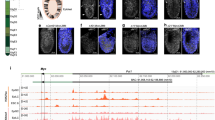Summary
When Drosophila melanogaster males coming from a class of strains known as inducer are crossed with females from the complementary class (reactive), a quite specific kind of sterile female (SF) is obtained that exhibits other dysgenic traits such as non-disjunctions and non-randomly distributed mutations. This syndrome is caused by the interaction of the ‘I factor’ linked to inducer chromosomes with the maternally inherited reactive state ‘R’. This I-R interaction is also responsible for ‘chromosomal contamination’ that is likely to result from very frequent I factor insertions into reactive chromosomes. Such insertions might be responsible for the I-R induced mutations and some data concerning this hypothesis are reported here.
Out of nine I-R-generated mutants one, the white IR1 (w IR1) allele, is closely linked to an I factor, which maps either at the site of the mutation or within less than 0.02 map units. In addition, w IR1 is somewhat unstable when transmitted through SF females.
In contrast, the typical I factor does not seem to be associated with any of the eight other mutants as judged by their inability to induce the female sterility characteristic of the I-R syndrome. The possibility is discussed that most of I-R-induced mutations are nevertheless caused by insertions of either undetectable I factors or other transposable elements, not related to I, whose transposition is dependent on the I-R interaction.
Similar content being viewed by others
References
Bingham PM (1981) A novel dominant mutant allele at the white locus of Drosophila melanogaster is mutable. Cold Spring Harbor Symp Quant Biol 45 (in press)
Bregliano JC, Picard G, Bucheton A, Pélisson A, Lavige JM, L'Héritier P (1980) Hybrid dysgenesis in Drosophila melanogaster. Science 207:606–611
Bucheton A, Bregliano JC: Inducer-reactive interaction in Drosophila melanogaster: heredity of the reactive condition (in preparation).
Bucheton A, Picard G (1978) Non mendelian female sterility in Drosophila melanogaster: hereditary transmission of reactivity levels. Heredity 40:207–223
David J (1959) Etude quantitative du développement de la Drosophile élevée en milieu axénique. Bull Soc Biol France et Belgique 93:472–505
Engels WR (1979) Extrachromosomal control of mutability in Drosophila melanogaster. Proc Natl Acad Sci USA 76:4011–4015
Gehring WJ, Paro R (1980) Isolation of a hybrid plasmid with homologous sequences to a transposing element of Drosophila melanogaster. Cell 19:897–904
Green MM (1959) Putative non reciprocal crossing over in Drosophila melanogaster. Z Vererbungsl 90:375–384
Green MM (1976) Mutable and mutator loci. In: Ashburner M, Novitski E (eds) The genetics and biology of Drosophila. Academic Press, New York, pp 929–946
Green MM (1977) The case for DNA insertion mutations in Drosophila. In: Bukhari AI, Shapiro JA, Adhya SL (eds) DNA insertion elements, plasmids and episomes. Cold Spring Harbor Laboratory, Cold Spring Harbor, New York, pp 437–445
Judd BH (1976) Genetic units of Drosophila-Complex loci In: Ashburner M, Novitski E (eds) The genetics and biology of Drosophila. Academic Press, New York, pp 767–799
Kidwell MG, Kidwell JF (1976) Selection for male recombination in Drosophila melanogaster. Genetics 84:333–351
Kidwell MG (1979) Hybrid dysgenesis in Drosophila melanogaster: the relationship between the P-M and I-R interaction systems. Genet Res Camb 33:205–217
Kidwell MG (1981) Intraspecific hybrid sterility. In: Ashburner M, Carson HL, Thompson JN Jr (eds) The genetics and biology of Drosophila, vol 3. Academic Press, New York (in press)
Lefevre G, Jr, Green MM (1972) Genetic duplication of the white-split interval of the X chromosome in Drosophila melanogaster. Chromosoma 36:391–412
Lindsley DL, Grell EH (1968) Genetic variations of Drosophila melanogaster. Carnegie Institution of Washington publication no 627
Pélisson A (1978) Non mendelian female sterility in Drosophila melanogaster: variations of chromosomal contamination when caused by chromosomes of various inducer efficiencies. Genet. Res Camb 32:113–122
Pélisson A, Bregliano JC (1981) The I-R system of hybrid dysgenesis in Drosophila melanogaster: construction and characterization of a non-inducer stock. Biol Cell 40:159–164
Pélisson A, Picard G (1979) Non mendelian female sterility in Drosophila melanogaster: I factor mapping on inducer chromosomes. Genetica 50:141–148
Picard G (1976) Non mendelian female sterility in Drosophila melanogaster: hereditary transmission of I factor. Genetics 83:107–123
Picard G (1978) Non mendelian female sterility in Drosophila melanogaster: further data on chromosomal contamination. Mol Gen Genet 164:235–274
Picard G (1979) Non mendelian female sterility in Drosophila melanogaster: principal characteristics of chromosomes from inducer and reactive origin after chromosomal contamination. Genetics 91:455–471
Picard G, Bregliano JC, Bucheton A, Lavige JM, Pélisson A, Kidwell MG (1978) Non mendelian female sterility and hybrid dysgenesis in Drosophila melanogaster. Genet Res Camb 32:275–287
Picard G, Lavige JM, Bucheton A, Bregliano JC (1977) Non mendelian female sterility in Drosophila melanogaster: physiological pattern of embryo lethality. Biol Cell 29:89–98
Picard G, Pélisson A (1979) Non mendelian female sterility in Drosophila melanogaster: characterization of the non-inducer chromosomes of inducer strains. Genetics 91:473–489
Prudhommeau C, Proust J (1981) Hybrid dysgenesis in Drosophila melanogaster: further evidence for and characterization of the mutator effect of the Inducer-Reactive interaction. Mutat Res (submitted)
Rasmuson B (1962) Evidence for a compound nature of the mutant alleles w a and w i in Drosophila melanogaster. Hereditas 48:612–618
Rubin GM, Brorein WJ Jr, Dunsmuir P, Levis R, Strobel E, Young, E (1981) “Copia-like” transposable elements in the Drosophila genome. Cold Spring Harbor Symp Quant Biol 45 (in press)
Tchurikov NA, Zelentsova ES, Ilyin YV, Ananiev EV, Georgiev GP (1981) Mobile dispersed genes in Drosophila melanogaster. Cold Spring Harbor Symp Quant Biol 45 (in press)
Young MW (1979) Middle repetitive DNA: a fluid component of the Drosophila genome. Proc Natl Acad Sci USA 76:6274–6278
Author information
Authors and Affiliations
Additional information
Communicated by W. Gehring
Rights and permissions
About this article
Cite this article
Pélisson, A. The I-R system of hybrid dysgenesis in Drosophila Melanogaster: Are I factor insertions responsible for the mutator effect of the I-R interaction?. Molec. Gen. Genet. 183, 123–129 (1981). https://doi.org/10.1007/BF00270149
Received:
Issue Date:
DOI: https://doi.org/10.1007/BF00270149




